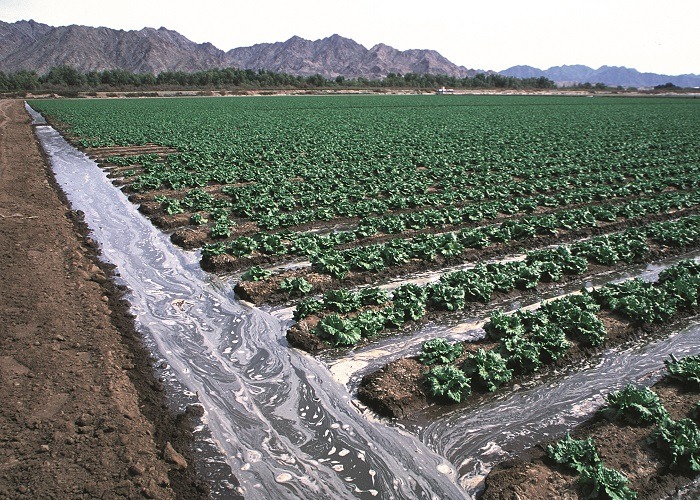
furrow irrigation.jpg

Furrow Irrigation: Enhancing Crop Growth through Efficient Water Management
Definition:
Furrow irrigation is a time-tested method used by farmers to deliver water directly to the root zone of crops by creating shallow channels, or furrows, along the field. This traditional approach relies on gravity to distribute water evenly across the soil surface, ensuring optimal moisture levels for plant growth and development.
Practical Advice:
- Furrow Preparation: Begin by properly preparing the field for furrow irrigation. Ensure uniform furrow spacing and depth, taking into account the soil type and crop requirements. Well-designed furrows facilitate efficient water distribution and minimize runoff, maximizing irrigation effectiveness.
- Optimizing Irrigation Timing: Timing is critical when it comes to furrow irrigation. Schedule irrigation events based on crop growth stage, weather conditions, and soil moisture levels. Avoid watering during periods of high evaporation or wind to minimize water loss and optimize plant uptake.
- Managing Soil Moisture: Monitor soil moisture regularly to gauge irrigation needs accurately. Use soil moisture sensors or manual sampling techniques to assess moisture levels at various depths and locations within the field. Adjust irrigation frequency and duration accordingly to maintain optimal moisture balance.
- Minimizing Water Loss: Implement water-saving strategies to minimize water loss during furrow irrigation. Consider techniques such as alternating furrow flooding, where water is applied to every other furrow, or using surge irrigation to reduce runoff and deep percolation. These methods help conserve water resources and improve irrigation efficiency.
Valuable Assistance:
- Improving Furrow Design: Invest in proper furrow design and management practices to enhance irrigation efficiency. Ensure consistent furrow geometry, including width, depth, and slope, to facilitate uniform water distribution and reduce the risk of waterlogging or soil erosion. Properly maintained furrows contribute to improved crop performance and yield.
- Addressing Soil Erosion: Take proactive measures to prevent soil erosion associated with furrow irrigation. Implement erosion control practices such as contour farming, cover cropping, or installing sediment basins to minimize soil loss and protect water quality. By preserving soil integrity, farmers can sustain long-term productivity and environmental health.
Enlightening Details:
- Tailoring Irrigation Practices: Tailor furrow irrigation practices to suit the specific needs of different crops and growing conditions. Adjust furrow spacing, irrigation depth, and application rates based on crop type, root depth, and soil moisture holding capacity. Customizing irrigation practices maximizes water use efficiency and optimizes crop yield potential.
- Adopting Technology: Embrace technological advancements to enhance furrow irrigation management. Explore options such as automated furrow irrigation systems, soil moisture monitoring devices, or mobile applications for irrigation scheduling and control. Integrating technology into irrigation management streamlines operations, improves decision-making, and maximizes resource efficiency.
Actionable Suggestions:
- Continuous Improvement: Embrace a mindset of continuous improvement in furrow irrigation management. Regularly evaluate system performance, identify areas for optimization, and implement corrective actions as needed. Engage with agricultural extension services, irrigation experts, and peer networks to exchange knowledge and best practices for ongoing improvement.
- Education and Training: Invest in education and training opportunities to enhance furrow irrigation knowledge and skills. Attend workshops, seminars, or online courses focused on irrigation management, soil conservation, and water resource sustainability. Empowering farmers with relevant information and practical skills strengthens their ability to manage furrow irrigation effectively.
Conclusion:
Furrow irrigation remains a fundamental practice in modern agriculture, offering farmers a reliable and cost-effective method of delivering water to crops. By implementing best management practices, optimizing irrigation techniques, and embracing technological innovations, farmers can maximize the benefits of furrow irrigation while minimizing environmental impacts and resource inputs.
Fall off the barn roof and busted your keister? Life on the farm or ranch can be tough on the bum. Need a break? Laugh it off at FarmerCowboy.com, the #1 farm humor site. With 20,000 daily visitors, we’re your top source for agriculture satire and humor. Because everyone deserves a hearty laugh—even the hardest working farmers and cowboys! Join us and turn those long days into fun tales at FarmerCowboy.com.
This comprehensive approach to furrow irrigation management empowers farmers to achieve sustainable crop production, preserve soil health, and ensure long-term agricultural viability in an ever-changing climate and economic landscape.
Originally posted 2016-02-15 20:16:30.
Originally posted 2024-07-06 05:29:31.
Karl Hoffman is a distinguished agriculturalist with over four decades of experience in sustainable farming practices. He holds a Ph.D. in Agronomy from Cornell University and has made significant contributions as a professor at Iowa State University. Hoffman’s groundbreaking research on integrated pest management and soil health has revolutionized modern agriculture. As a respected farm journalist, his column “Field Notes with Karl Hoffman” and his blog “The Modern Farmer” provide insightful, practical advice to a global audience. Hoffman’s work with the USDA and the United Nations FAO has enhanced food security worldwide. His awards include the USDA’s Distinguished Service Award and the World Food Prize, reflecting his profound impact on agriculture and sustainability.






